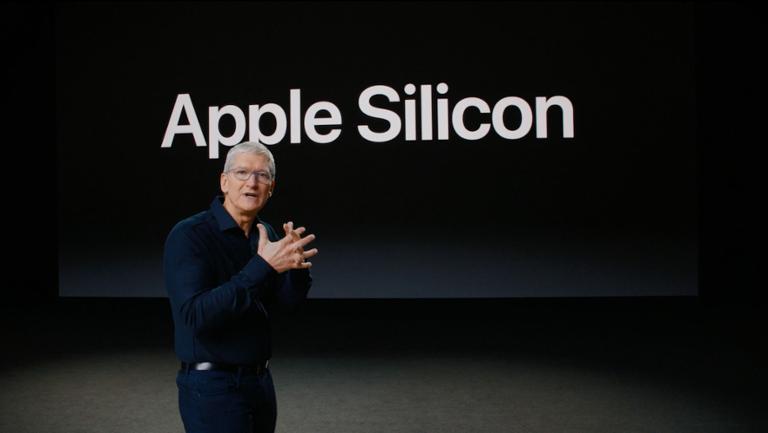As long rumored, Apple is transitioning its Mac lineup away from a reliance on Intel processors. Going forward, Apple’s desktop environment will adopt ARM-based SoC architecture. That’s right, the Mac is relying on the same silicon that powers the iPad and iPhone.
Apple, carefully dancing around the ARM discussion by naming its SoCs “Apple Silicon,” touts how the deeper integration will allow the company full control over its Mac hardware and software (just as it has now with the iPhone and iPad). The first “Apple Silicon” Macs will arrive later this year; onstage at Apple’s WWDC 2020 keynote, CEO Tim Cook (seen above) noted there were still Macs with Intel chipsets in the pipeline (the company is supposedly “excited” about those).
Developers will have a “Quick Start Program” that will walk them through the transition. It provides access to documentation, support forums, beta versions of Xcode 12 (which includes the tooling necessary to create or port apps for the ARM-based Macs), a beta build of the latest macOS build (named “Big Sur”), and a Mac Mini with an ARM-based SoC (the “A12Z Bionic System on a Chip”).
This Mac is dubbed the “Developer Transition Kit,” or DTK, and will cost $500. From Apple (emphasis ours):
The DTK, which must be returned to Apple at the end of the program, consists of a Mac mini with Apple’s A12Z Bionic SoC inside and desktop specs, including 16GB of memory, a 512GB SSD, and a variety of Mac I/O ports.
Apple will continue to use its A-series naming scheme for SoCs designed for the Mac, though it will append a ‘z’ to the processor (much as it uses an ‘x’ for the iPad version of its A-series processors). This is the first example of how Apple sees its Macs fitting into its lineup: The plain ‘A’ SoC is for iPhone, the ‘x’ version for iPad, and ‘z’ is designated for Macs.
The versioning of this SoC scheme hints at the power behind each chipset. A Mac necessarily needs more processing power than an iPhone or iPad. “From the beginning, the Mac has always embraced big changes to stay at the forefront of personal computing. Today we’re announcing our transition to Apple silicon, making this a historic day for the Mac,” said Cook. “With its powerful features and industry-leading performance, Apple silicon will make the Mac stronger and more capable than ever.”
Big Sur
Big Sur carries a lot of changes that appear (literally) to make the Mac more like its mobile counterparts. Icons are now “squircles” instead of vector iconography, and features such as the Notification Center and Finder all have a lot more ‘breathing room’ between rows and sections. Even the Messages app adopts mobile-first features such as stickers, confetti and lasers when sending particular messages. Though Apple glossed over it, watchful eyes saw an App Store icon within the Messages app for Mac displayed during the keynote.
This is a second example of how Apple views its Macs within its larger ecosystem: Though powerful, they will adhere more closely with the company’s design language and functionality found on its mobile devices. And mobile apps without a desktop counterpart can now be utilized on a Mac in a smaller, windowed view. Apple has quietly created a universal platform that may actually work.
What About Developers?
Two features will figure heavily in this two-year transition: Universal 2 and Rosetta 2.
Universal 2 is a one-size-fits-all-apps binary that allows apps to work on Intel or Apple Silicon-based Macs. The Rosetta 2 emulator translates older Mac apps to work on new machines at run-time.
It should be noted Apple doesn’t seem to be asking developers to do anything in terms of retooling apps. Both Universal 2 and Rosetta 2 are billed as build or runtime features that work behind the scenes to ensure all Mac apps will be able to operate across machines for the foreseeable future.
And Xcode? Again, from Apple:
Xcode 12 is built as a Universal app that runs 100% natively on Intel-based CPUs and Apple Silicon for great performance and a snappy interface.* It also includes a unified macOS SDK that includes all the frameworks, compilers, debuggers, and other tools you need to build apps that run natively on Apple Silicon and the Intel x86_64 CPU.
There’s another key feature: Opening a project in Xcode 12 automatically updates an app with release builds for all of Apple’s platforms (which, again, are now all A-series SoC-based). The new builds have a binary “slice” for Apple Silicon and another for Intel x-series CPUs, which are cobbled together into a single binary for submission to the App Store.
This brings up the third key aspect of this transition: Apple now fully controls distribution of apps for its platforms. This is also why it added the ability to share purchases with others in your family group via the Mac this year, and new <code>StoreKit</code> features for subscriptions and in-app purchases.
All signs point to the new Macs with A-series processors adhering to the same locked-down ecosystem as iPhones and iPads. This ‘universal app build’ could also be a precursor for a unified App Store down the line.
Apple has never supported loading apps from sources other than the App Store on iPad, iPhone, or Apple Watch. Control of its hardware and software affords Apple the opportunity to make class-leading devices, but limits choice for users. When it comes to downloads, the Mac was the last bastion of freedom in Apple’s ecosystem.
Conclusion
There are naturally pros and cons to this new situation. Building and updating apps to work across Apple’s entire lineup just became incredibly simple; like Catalyst did for porting iPadOS apps to the Mac, Xcode with Universal 2 just sort of does the binary-splitting-and-sewing for you to make older Mac apps available to Apple Silicon. Rosetta 2 makes sure apps you already have work on new Macs if you fail to update them.
It’s just not clear what happens from here. Apple once asked that developers 'notarize’ their apps, which was an olive branch to developers who weren’t interested in the Mac App Store. Now it seems the company will wall off its desktop garden, too. It hasn’t explicitly said as much, but the undertow of WWDC 2020 is that non-native apps for macOS are on notice: assimilate or die.
This transition is set to take two years, though it’s unclear what happens 24 months from now for apps that aren’t updated. What happens if Vim, eMacs, Visual Studio, Atom, or some other IDE isn’t updated to work with Apple Silicon? You may scoff, but there are still apps that don’t support dark mode; maybe their developers decide the Mac platform just isn’t worth supporting.
ARM (err, Apple Silicon) will undoubtedly make Macs better. They will have more apps via iOS and iPadOS, and using the Mac may no longer present a learning curve for mobile-first users. Apple can massage its SoC and other hardware to suit its needs. The Mac will be more secure.
Apple Silicon is also an ultimatum. After spending years trying to encourage developers to write apps for Mac, or port iPadOS apps, it’s simply making the Mac more like a mobile device on the hardware and software fronts while steering apps onto the desktop—because the earlier scheme didn’t work.



